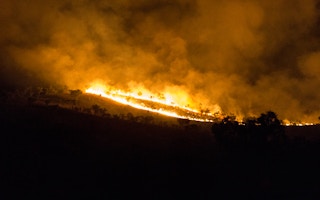Australian forests, devoured by devastating wildfires in the last southern hemisphere summer, set a new high − a huge smoke cloud that soared more than 20 miles into the upper atmosphere and stayed there for months.
An international team of scientists reports in the Nature journal Communications Earth and Environment that they tracked the cloud to an altitude of 35 kilometres (21 miles).
They measured it as 1,000 kms (625 miles) across. They followed it around the planet for 66,000 kms (41,010 miles). And they confirm that it remained intact for three months.
This high-flying pollution wasn’t the first such instance: just three times the size of any observed predecessor. Until now the record was held by plumes soaring from forest fires in western Canada in 2017.
Growing intensity
“When I saw the satellite measurement of the smoke plume at 35 kms, it was jaw-dropping. I never would have expected that”, said Adam Bourassa of the University of Saskatchewan in Canada, one of the researchers.
“We’re seeing records broken in terms of the impact on the atmosphere from these fires. Knowing that they’re likely to strike more frequently and with more intensity due to climate change, we could end up with a pretty dramatically changed atmosphere.”
A blaze that can make a new cloud 35 kms above its surface is an indicator both of the potential devastation of climate change driven by profligate human use of fossil fuels and of the intricate workings of the biosphere and atmosphere.
After months of desperate drought in 2019, eastern Australia effectively caught fire. Around 110,000 sq kms of bush, forest and grassland went up in smoke: with them went thousands of homes and millions of wild and domestic animals. Altogether 33 people died.
So huge and sustained were the fires, and so dense the smoke, that the fires began to generate their own thunderstorms, known as pyrocumulonimbus, to create powerful updrafts to carry the aerosols and soot far above the flight paths of the highest jet airliners.
Researchers from France, the UK and Canada used sensitive satellite readings to track the sustained smoke signal from a part-incinerated island: at altitude, it was still dense enough to absorb, scatter and weaken the sunlight falling on the Earth below.
“What was also really amazing was that as the smoke sits in the atmosphere, it starts to absorb sunlight and so it starts to heat up,” Professor Bourassa said.
“And then, because it’s getting hotter, it starts to rise in a swirling vortex bubble, and it just rose higher and higher through the atmosphere.”
This story was published with permission from Climate News Network.

















